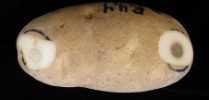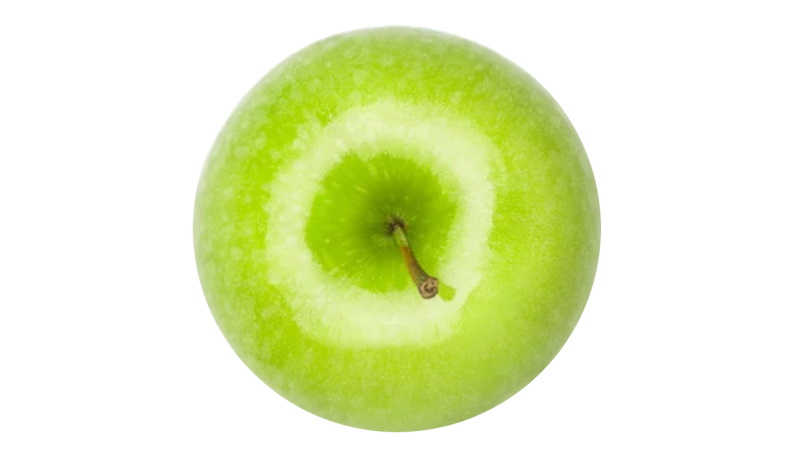Put The Brakes On Bruises

To begin, there are a couple of types of bruises that impact potatoes: black spot bruise and shatter bruise. We’ll begin by describing black spot bruise.
Black spot bruise results from an impact that does not break the tuber skin but damages several layers of cells beneath the skin, causing a chemical reaction. During this reaction, tyrosine (a substrate) mixes with a copper-containing protein, polyphenol oxidase (an enzyme), commonly called PPO. Dihydroxyphenyl-alamine (DOPA) is formed from this reaction, which is further oxidized (oxygen is added) producing several intermediate compounds. The end product of this reaction is melanin, which causes a black, gray, or brown discoloration in tubers normally referred to as black spot bruise. The reaction takes 24 to 48 hours to complete, and the damage cannot be seen unless the tuber skin is removed.
Shatter bruise, on the other hand, occurs when the tuber skin and possibly several layers of cells underneath the skin are cracked or broken by an impact. Tuber cracks may become more visible upon drying.
Tuber Physical Properties Affecting Bruise
Large tubers have a larger potential to be damaged compared with smaller ones, and a small radius (pointed tuber end) is more likely to be damaged compared with a large radius (round tuber end). The smaller radial end of a tuber is more likely to be damaged because the force of the impact is confined to a smaller area. Likewise, larger cells have a greater potential to be damaged from an impact than smaller cells. Also, after tubers have been in storage for about one month, they can withstand 30% to 80% more impact without black spot bruising compared to the impact that causes bruising at harvest.
Tuber Susceptibility To Black Spot Bruise
Black spot bruise is a chemical reaction, so not only does the force of the impact determine whether or not a tuber will be damaged, but the internal quality of the tuber also plays a role. Nitrogen and phosphorus play an indirect role in potential black spot bruising in that potato plants lacking these two nutrients will likely die earlier than adequately fertilized plants, thus, resulting in more mature tubers, and more mature tubers have a higher susceptibility to black spot bruising. Cultural practices or environmental conditions (for example, hot weather) that physiologically age tubers will result in tubers with a higher black spot bruise potential during harvest and handling.
Not all potato varieties are equally susceptible to black spot bruise. For example, Ranger Russet is very susceptible to black spot bruise while Russet Burbank is rated as susceptible. Susceptibility of a particular variety to black spot bruise is a combination of its physical and chemical properties. Physical properties include tuber and cell size. Chemical differences in black spot bruise susceptibility among varieties are largely due to the amount of tyrosine. Varieties with more tyrosine are more susceptible. Also, tubers with high specific gravity, under the right conditions, have a higher potential to black spot bruise than those with lower specific gravity. However, specific gravity variation within a variety has a greater effect on black spot bruise than the specific gravity among varieties. That is, not all varieties with high specific gravity are more susceptible to black spot bruise than those with lower specific gravity.
Growing Conditions Affecting Black Spot Bruise
A grower-field survey was conducted and found that tubers harvested from vines that were rated in late August as more mature (less green) tended to black spot bruise more than tubers harvested from plants that were less mature (more green). For Russet Burbank, more black spot bruising occurred on tubers harvested from fields that had 70% or more dead vines in August, and for Ranger Russet more black spot bruising resulted from fields where 20% or more of the vines were dead.
This indicates there are varietal differences. They also reported that tubers with higher specific gravity generally were more susceptible to black spot bruising. Russet Burbank tubers with specific gravity above 1.080 and Ranger Russet tubers with specific gravity about 1.085 were more susceptible to black spot bruising than tubers with lower specific gravity.
A third factor in the survey was available soil moisture. Fields with lower available soil moisture (less than 50%) at harvest tended to have more black spot bruising. When researchers analyzed the 1994 data to determine how much the above factors contributed to potential black spot bruise, they found that vine maturity accounted for 21% of the variability. Specific gravity plus vine maturity accounted for 35% of the black spot bruise potential. Altogether, vine maturity, specific gravity, and field moisture accounted for just over half of the measured black spot bruise.
Determining Vine Kill Date
Black spot bruise potential has been reported to in increase as plants mature as discussed above, so killing plants with green vines should help to decrease black spot bruise. Consequently, it would seem logical to assume that killing mostly green plants would decrease yield. However, research at the Aberdeen R & E Center in Idaho has shown that as soon as vines (stems) begin to naturally die, the tuber bulking rate rapidly decreases, resulting in less of a negative impact on yield than might be expected.
Harvest Management Considerations
Colder tuber pulp temperatures increase damage whether it is shatter or black spot bruise. Ideally, tubers should be harvested when pulp temperatures are 50 to 60 degrees F. An upper limit of 60 degrees F is used because it could be challenging to remove field heat in storage, resulting in higher rot potential. A critical management practice to employ for minimizing bruising is to monitor tuber pump temperature of every truckload during harvest. This may require harvesting at different times during the day to allow the tubers to warm up or cool down to the proper temperature.
A second harvest management practice is to minimize tuber drop height. There is not a set maximum drop height because other factors such as tuber load on the conveyors, tuber temperature and tuber hydration all affect tuber damage. However, keeping drop heights on all harvesting and handling equipment to no more than 6 inches would be ideal.
Harvester Timing
The harvester is the most likely piece of equipment that will damage tubers. This is particularly true if the conveyors are running too fast. Tuber damage may be lessened by slowing the conveyor speed and keeping the conveyors loaded to capacity so tubers are dropping onto other tubers and not an empty conveyor. Tubers hitting other tubers are damaged less. The rear-cross conveyor on the harvester likely causes the most damage because tubers drop and change direction at the same time.
A quick and easy way to determine if the rear-cross conveyor is running too fast is to operate the harvester normally in the field and then suddenly stop — be sure to warn the truck driver so you don’t tear the boom off the harvester. Then, observe how the tubers are loaded on the conveyor. A properly adjusted rear-cross conveyor will have two or more layers of tubers on it.
If you see a single layer of tubers, it is running too fast and needs to be slowed. Be cautioned, though, that on some harvesters, if the rear-cross is slowed too much, there is the possibility of tubers being damaged by the secondary conveyor striking the tubers.
Properly adjusted harvester conveyor speeds are based on harvesting ground speed. The primary conveyor should operate at 120% to 150% of ground speed in heavy soil or 100% to 120% in sand. The secondary should run at 65% of ground speed, and the remaining conveyors should operate at 50% to 70%.
For more information, go to www.cals.uidaho.edu/potato/Research&Extension/Topic/Harvest/PotatoHarvestManagement-06.pdf









